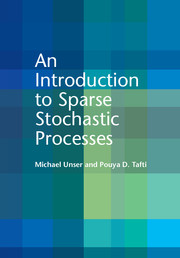Book contents
- Frontmatter
- Dedication
- Contents
- Preface
- Notation
- 1 Introduction
- 2 Roadmap to the book
- 3 Mathematical context and background
- 4 Continuous-domain innovation models
- 5 Operators and their inverses
- 6 Splines and wavelets
- 7 Sparse stochastic processes
- 8 Sparse representations
- 9 Infinite divisibility and transform-domain statistics
- 10 Recovery of sparse signals
- 11 Wavelet-domain methods
- 12 Conclusion
- Appendix A Singular integrals
- Appendix B Positive definiteness
- Appendix C Special functions
- References
- Index
3 - Mathematical context and background
Published online by Cambridge University Press: 05 September 2014
- Frontmatter
- Dedication
- Contents
- Preface
- Notation
- 1 Introduction
- 2 Roadmap to the book
- 3 Mathematical context and background
- 4 Continuous-domain innovation models
- 5 Operators and their inverses
- 6 Splines and wavelets
- 7 Sparse stochastic processes
- 8 Sparse representations
- 9 Infinite divisibility and transform-domain statistics
- 10 Recovery of sparse signals
- 11 Wavelet-domain methods
- 12 Conclusion
- Appendix A Singular integrals
- Appendix B Positive definiteness
- Appendix C Special functions
- References
- Index
Summary
In this chapter we summarize some of the mathematical preliminaries for the remaining chapters. These concern the function spaces used in the book, duality, generalized functions, probability theory, and generalized random processes. Each of these topics is discussed in a separate section.
For the most part, the theory of function spaces and generalized functions can be seen as an infinite-dimensional generalization of linear algebra (function spaces generalize ℝn, and continuous linear operators generalize matrices). Similarly, the theory of generalized random processes involves the generalization of the idea of a finite random vector in ℝn to an element of an infinite-dimensional space of generalized functions.
To give a taste of what is to come, we briefly compare finite- and infinite-dimensional theories in Tables 3.1 and 3.2. The idea, in a nutshell, is to replace vectors by (generalized) functions. Formally, this extension amounts to replacing some finite sums (in the finite-dimensional formulation) by integrals. Yet, in order for this to be mathematically sound, one needs to properly define the underlying objects as elements of some infinite-dimensional vector space, to specify the underlying notion(s) of convergence (which is not an issue in ℝn) while ensuring that some basic continuity conditions are met.
Fundamental to our formulation is the material on infinite-dimensional probability theory from Section 3.4.4 to the end of the chapter. The mastery of those notions requires a good understanding of function spaces and generalized functions, which are covered in the first part of the chapter.
- Type
- Chapter
- Information
- An Introduction to Sparse Stochastic Processes , pp. 25 - 56Publisher: Cambridge University PressPrint publication year: 2014



